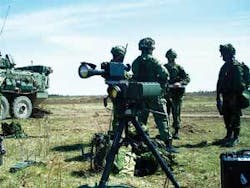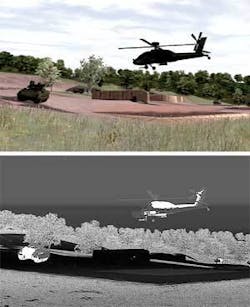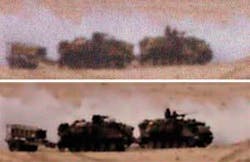By Courtney E. Howard
Accuracy is of paramount importance to warfighters on the battlefield, whether on the ground, in the air, or on sea. For this reason, military forces rely on electro-optical solutions, such as thermal weapon sights, to provide a clear and immediate picture of their vast surroundings at all times.
“The term thermal weapon sight (TWS), when narrowly defined, refers to a specific set of Army programs and specific types of weapon sights,” says David Strong, vice president of marketing for FLIR’s Government Systems Division in Billerica, Mass. “If taken in a broader context, thermal weapon sight refers to a wide range of products and applications, including almost anything, from sights for individual weapons to thermal sights mounted on tanks, helicopters, and ships.”
Thermal-weapon-sight solutions are indeed as numerous and as varied as the applications they serve in military environments today. Thermal weapon sights tap the latest infrared technologies to aid warfighters in target acquisition, location, and identification; situational awareness; friend-versus-foe determination; reconnaissance and surveillance; and so on. Today’s armed forces are taking advantage of multiple sensors at once to serve all these functions simultaneously.
Field-proven and battle-tested in Afghanistan and Iraq, FLIR Systems’ SeeSpot III rugged thermal imager allows operators to identify targets and view laser designators simultaneously.
One of the latest and most innovative applications of multisensor thermal- imaging technology, according to FLIR’s Strong, is the use of long-range, mast-mounted sights on vehicles. In answer to the military’s need for long-range, mounted, and rugged thermal imagers, FLIR Systems unveiled the Star SAFIRE LV during the Association of the U.S. Army (AUSA) show held in Washington in October. The Star SAFIRE LV, designed for vehicle-mounted military operations on urban terrain (MOUT) and force-protection applications, combines long-range thermal imaging with visible-light imaging and a target geo-location capability in a rugged design that extends beyond MIL-spec requirements. “FLIR will be announcing additional new products in the first half of the year,” Strong says. “We also have announced a number of new contracts, many of them associated with the force-protection role, where the requirement is to rapidly identify and locate threats to our warfighters so that these threats can be eliminated.”
After speaking with their Department of Defense clientele, FLIR engineers and executives say they hear there is a need for increasing precision in locating targets at greater standoff ranges, as well as increased precision in identifying those targets. “This means the use of multiple sensor technologies, together with long-range optics and sensor stabilization,” Strong says. “It also means the use of very high-resolution digital imagery in order to view fine details and to distinguish friend from foe, target from decoy.”
Information is in the details
Image quality is perhaps more important on the battlefield than anywhere else, yet infrared imagery is often lacking clarity and detail. This fact was not lost on Rick Puetter, who applied his background in thermal-infrared astronomy to develop an image-processing technique specifically to enhance the resolution of thermal-infrared images.
“PixonImaging’s image-processing technology works well for infrared electro-optics and thermal weapons sights,” says Puetter, chief executive officer of PixonImaging in San Diego. “It removes image blur, often a very serious problem of the IR and especially the thermal IR; decreases noise, which can be especially problematic for the thermal IR; and increases local image constant.”
Quantum3D’s Independence IDX 3000 ER system generates a simulated out-the-window view (top) with a high level of detail and realism, and a simulated infrared view (bottom) with sensor post-processing effects applied to ensure fidelity to real-world scenarios in military training and simulation environments.
Image blur can be caused by a number of effects, Puetter says. In military environments, atmospheric turbulence and diffraction are two main causes. “Atmospheric turbulence perturbs the multiple beams of light coming from a given source, since the different beams of light pass through different portions of the atmosphere and are bent in slightly different directions, causing the ensemble of all the light from a given source to be blurry.”
Diffraction, on the other hand, is blurriness caused by the wave nature of light. The ability for a camera, given the diameter of its primary lens or mirror, to focus light to a point becomes poorer as the wavelength of the light becomes longer. Infrared typically refers to short-wavelength light, whereas thermal infrared is long-wavelength light. “Diffraction causes long-wavelength light to be blurrier than short-wavelength light,” explains Puetter. “To give specific examples, thermal infrared (I’ll assume a wavelength of 10 microns) is 20 times blurrier than optical light (0.5 microns) and five times blurrier than infrared (assuming 2 microns). Our technology can remove both atmospheric and diffraction blurring, especially problematic for thermal infrared. For example, for a camera with an objective of 100 mm in diameter, the size of the 10-micron (thermal IR) diffraction blur is roughly 20 seconds of arc, or about 10 or more times worse than typical atmospheric blurring.”
Noise in the image also degrades clarity and overall quality, and it can come from many sources, such as camera electronics, low-light conditions, and even thermal background emission from the sky and ground. “Noise from low light level can’t be helped at night,” Puetter explains. “Because the signal is very weak, the camera signal amplification is turned up high and noise is due to the random arrival rates of photons [called counting statistics or Poisson noise]. Thermal infrared has special problems with noise. Thermal infrared is useful because people glow at these wavelengths; but so does everything else-the ground, the air, the camera. So in thermal infrared, random variations in the emission level from the source you’re interested in and the surrounding background cause noise. It’s a big noise source and comes from everywhere.”
PixonImaging’s image-processing technology was developed specifically to improve the resolution and quality of thermal electro-optics imagery, such as through the removal of noise that degrades image clarity (as shown in this comparison).
Technology from PixonImaging is, therefore, designed to address and reduce all sources of random noise, and adaptively increase local image contrast. Contrast adjustment is performed individually for each pixel in the image. That is, regions of deep shadow are adjusted differently from regions of glaring sunlight so that low-contrast features and details normally lost are highlighted and easier to see. Video is a common standard for IR imaging systems today, and the PixonVision PV-200 plugs into a tank’s, aircraft’s, or ship’s video stream, between the camera and display, to provide high-quality imagery immediately to warfighters. Puetter also revealed plans to add a powerful haze, mist, smoke, and fog remover, targeted at providing significant new capabilities in maritime and desert applications or in dusty or smoky battlefield conditions.
“The benefits our solution offers warfighters in the field are clear,” Puetter says. “The ability to see more details via increased resolution, reduced noise, and increased contrast allows the warfighter to identify targets, separate friend from foe, assess damage, and improve intelligence-all at greatly increased decision speed. These are winning advantages that translate directly into saved lives.”
Training for IR technology
Visual accuracy is not only necessary on the field, but also critical during military training exercises. IR and thermal weapon sights and other imaging devices can have a steep learning curve; it takes practice and some adjustment to use such solutions effectively. As a result, Quantum3D in San Jose, Calif., has unveiled simulation and training technology for U.S. and allied military that precisely mimics IR and other electro-optic information. In fact, Quantum3D’s commercial-off-the-shelf (COTS) sensor simulation products are used in training devices (for the F-15E, T-38, TH-57C FIT, F-16 Maverick, and C-130), engineering simulators (of the B2-PES, F-35 ACS, F-22 ACS, and AH-64D EDS), and hardware in the loop (HWIL) simulators used to validate missile seekers and trackers.
“Given the prevalence of sensor use in both the U.S. and allied military forces, high-fidelity sensor simulation has become absolutely essential in today’s military training applications,” says Ross Q. Smith, Quantum3D cofounder and president. “We strive to provide the highest degree of fidelity possible in our simulation systems simply because to do anything less would likely introduce artifacts that may cause negative training. Negative training means that the training system does something that the real system does not. So if, in the training system, one can engage a target at 25 kilometers, while in the real system, one can engage a target at 20 or 30 kilometers, there is a 5- kilometer difference between the real world and the simulated world. Those 5 kilometers can mean life or death in combat; and if a warfighter develops bad habits in the simulator and they bring those bad habits with them to the battlefield, we’ve just done them a huge disservice. This need for fidelity permeates training systems, but weapon systems are possibly the most important things we simulate, since they really do mean life or death to soldiers that use them.”
Smith describes Quantum3D’s technology as simulating the actual physics of the materials in the synthetic/simulation environment in terms of their response in the appropriate IR wavelengths under exacting time-of-day, thermal loading, and atmospheric conditions to create the at-aperture simulation of what the IR sensor would see. The resulting image is then post-processed with high-speed field programmable gate arrays (FPGAs) to simulate the types of artifacts that the real sensor electronics provide, such as halos, blurring, sharpening, tracking, and the like.
“We do all this in real time, so that there is no perceivable delay between things happening in the simulated environment and what the pilot, WSO, or gunner/commander sees,” Smith explains. “It’s easy to do low-fidelity simulation fast or high-fidelity simulation slow, but we do high-fidelity, 16-bit, physics-based IR and night-vision goggle [NVG] simulation at 30 hertz, good for tanks and gunnery; 60 hertz, for aircraft and weapons systems trainers; and 200 hertz and above, for HWIL.”
Quantum3D technology processes the IR physics of an entire scene in the AH-64D engineering development simulator in 16.67 milliseconds, which is essential for real-time response in a helicopter or fast-jet. The company’s solutions also ensure the IR scenes correlate with other scenes in the simulation, to provide an accurate out-the-window view aligned with data from sensors such as radar or NVG.
The company’s Independence IDX 2500 ER and now IDX 3000 ER families of image-generator solutions take advantage of Quantum3D enhanced sensor simulation technology (QUEST) to provide high-fidelity, real-time, 16-bit sensor simulation capability. QUEST solutions are being used in IR training devices, engineering simulators, and HWIL simulators in use by the U.S. Air Force, U.S. Army, U.S. Navy, U.K. ministry of defense, U.S. Missile Defense Agency, Japan defense agency, and Republic of Korea air force to prepare soldiers for the battlefield.
Investing in innovation
Warfighters in the field require a great deal more than accuracy from their electro-optics devices. Ideal solutions should be lightweight, compact, durable, silent, responsive, and battery powered.
And technology companies such as DRS Technologies, Teledyne, FLIR, and others are investing in taking the latest electro-optics systems to the field. FLIR management, for example, has invested heavily in the areas of high-definition infrared and visible range sensors, and fielding these capabilities in the battlefield. “All this technology has to be integrated together into a package that can survive the extreme rigors of desert use, including temperature extremes, sand and dust exposure, and other factors that in many cases requires engineering the products beyond the normal standards for MIL-SPEC testing, so that they will survive and be reliable,” FLIR’s Strong says. “The wide variety of thermal weapon sights and, in particular, the wide variety of applications demonstrate not only what these technologies are capable of, but also that the various U.S. military branches and those of our allies are moving at a high rate to field the best available technologies to warfighters. When you consider what these sensors are capable of, and how they can protect our forces, it’s truly astounding. We at FLIR have been in this business a long time, and the level of commitment we’re seeing to getting these capabilities into the hands of our troops in the field, in quantity, quality, and capability, is really unprecedented.”



